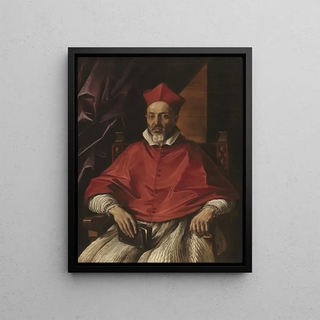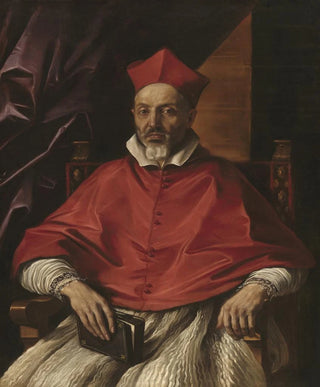Art print | Cardinal Francesco Cennini - Guercino


View from behind

Frame (optional)
In the vibrant universe of Baroque painting, the artwork "Cardinal Francesco Cennini" by Guercino stands out for its emotional intensity and striking realism. This painting, which immortalizes the cardinal in majesty, transports us to a time when art was both a means of personal expression and a tool of power. The depiction of the cardinal, with his penetrating gaze and finely detailed features, showcases Guercino's skill in capturing the psychology of his subjects. Contemplating this piece, one feels an immediate connection to the past, an invitation to explore the subtleties of the human condition through the lens of art.
Style and uniqueness of the artwork
Guercino's style, characterized by a bold use of light and shadow, gives "Cardinal Francesco Cennini" a depth and an almost sculptural dimension. The meticulous details of the cardinal's face, combined with dramatic lighting, create an atmosphere that is both solemn and intimate. The color palette, rich and warm, evokes a sense of human warmth while highlighting the dignity of the depicted figure. Every brushstroke seems charged with emotion, revealing not only the stature of the cardinal but also his role in the society of his time. This piece is not just a portrait; it becomes a living testimony of an era marked by power struggles and spiritual aspirations.
The artist and his influence
Guercino, whose real name is Giovanni Francesco Barbieri, is one of the masters of Italian Baroque, whose influence extends well beyond his era. Trained in the tradition of realism, he evolved towards a more dramatic style, incorporating elements of movement and emotion that captivated audiences of his time. His innovative approach inspired many artists, both contemporary and subsequent, to explore the limits of pictorial expression. By painting "Cardinal Francesco Cennini," Guercino does not merely depict a man but captures the very essence of spirituality and ecclesiastical power. This artwork thus reflects his creative genius

Matte finish

View from behind

Frame (optional)
In the vibrant universe of Baroque painting, the artwork "Cardinal Francesco Cennini" by Guercino stands out for its emotional intensity and striking realism. This painting, which immortalizes the cardinal in majesty, transports us to a time when art was both a means of personal expression and a tool of power. The depiction of the cardinal, with his penetrating gaze and finely detailed features, showcases Guercino's skill in capturing the psychology of his subjects. Contemplating this piece, one feels an immediate connection to the past, an invitation to explore the subtleties of the human condition through the lens of art.
Style and uniqueness of the artwork
Guercino's style, characterized by a bold use of light and shadow, gives "Cardinal Francesco Cennini" a depth and an almost sculptural dimension. The meticulous details of the cardinal's face, combined with dramatic lighting, create an atmosphere that is both solemn and intimate. The color palette, rich and warm, evokes a sense of human warmth while highlighting the dignity of the depicted figure. Every brushstroke seems charged with emotion, revealing not only the stature of the cardinal but also his role in the society of his time. This piece is not just a portrait; it becomes a living testimony of an era marked by power struggles and spiritual aspirations.
The artist and his influence
Guercino, whose real name is Giovanni Francesco Barbieri, is one of the masters of Italian Baroque, whose influence extends well beyond his era. Trained in the tradition of realism, he evolved towards a more dramatic style, incorporating elements of movement and emotion that captivated audiences of his time. His innovative approach inspired many artists, both contemporary and subsequent, to explore the limits of pictorial expression. By painting "Cardinal Francesco Cennini," Guercino does not merely depict a man but captures the very essence of spirituality and ecclesiastical power. This artwork thus reflects his creative genius






